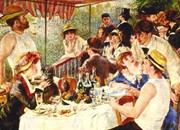Phillips Art Collection
Washington DC Fine Arts Museum: History,
Acquisitions, Impressionist Collection Highlights.
![]()
|
Phillips Art Collection |
 Luncheon of the Boating Party (Le Dejeuner des Canotiers) (1881) By Pierre Auguste Renoir. |
Phillips Art Collection, Wahington DCContents • Exceptional
Museum of Modern Art |
|
BEST ART MUSEUMS
IN AMERICA |
|
OTHER TOP ART MUSEUMS ART COURSES: WASHINGTON
DC HOW TO JUDGE A PAINTING BEST EUROPEAN GALLERIES |
Exceptional
Museum of Modern Art |
|
|
The museum's founder Duncan Phillips (1886–1966) was born in Pittsburgh but soon moved to Washington DC where, with support from his mother, he established The Phillips Memorial Gallery to commemorate the untimely deaths of his father and brother. Using a purpose-built space above the north wing of his Georgian Revival home as a public gallery, he started with a modest family art collection which he expanded dramatically. When in 1930 the collection reached 600 works, the Phillips family moved out of their house which was then converted completely into an art museum. Phillips - a published art critic, editor of the short-lived periodical Art and Understanding (1929), and author of the Venetian art book The Leadership of Giorgione (1937) - was not afraid of backing his own views about fine art. He collected canvases by El Greco, because he considered him the first passionate expressionist; Jean Chardin, whom he saw as the first modern painter; Goya, because he was the link between the Old Masters and the post-Impressionists like Paul Cezanne; and Edouard Manet because his work, too, led to great moderns like Paul Gauguin and the Fauvist Henri Matisse. His confidence led him to hang paintings in non-chronological arrangements according to visual connections which he thought they had - a characteristic feature of the Phillips Collection which endures to this day. |
|
|
In addition to buying seminal works of art, such as Luncheon of the Boating Party (1880–81) by Pierre-Auguste Renoir, and The Repentant St. Peter (c.1600–5) by El Greco, Phillips had certain favourite artists whose works he collected keenly. These included the colourful Intimist painter Pierre Bonnard; the co-founder of Cubism Georges Braque; the German Swiss fantasy painter Paul Klee; and the inventor of luminous Colour Field painting Mark Rothko. The Phillips Museum was one of the first venues to give Rothko an exclusive room allowing his works to saturate the space with colour. Another side to Phillips' acquisitions policy was his habit of buying fine art paintings by relatively unknown artists, such as Georgia O'Keeffe, Nicolas de Stael, Milton Avery, Arthur Dove, and Augustus Vincent Tack. These works formed what he called his "encouragement collection". Duncan Phillips passed away in 1966, to be succeeded him as museum director first by his wife Marjorie (in 1966), and then his son Laughlin (in 1972), who placed The Phillips Collection on a more secure footing. In the early 2000s, in order to facilitate its expanding collection and activities, the Museum underwent a major enlargement which added an extra 30,000 square feet to its space. Completed in 2006, without upsetting the intimate mood of the building, the expansion has enabled the development of The Phillips Collection Center for the Study of Modern Art, and has greatly improved the Museum's art appreciation and educational classes. Today, the Museum offers a busy program of gallery talks, lectures, workshops, and teacher training programs, as well as a full outreach program for District of Columbia Public Schools, featuring a variety of education projects, and interactive resources.
The Phillips' collection began as a museum of modern art, exemplifying Paris-based European art movements such as French Realism (c.1850 onwards) Impressionism (c.1873-83), Post-Impressionism (c.1880 onwards), Fauvism, Intimism, Expressionism, Primitivism, Symbolism, and Cubism, before taking on 20th century styles such as Precisionism, American Realism, Ashcan School, Abstract Expressionism, Colour Field painting, Kinetic art, and geometric abstract art. It consists of almost 3,000 works of European and American art. The former includes works by: Honore Daumier, Gustave Courbet, Edgar Degas, Pierre-Auguste Renoir, Claude Monet, Paul Cezanne, Paul Gauguin, Vincent van Gogh, Jacques Villon, Pierre Bonnard, Edouard Vuillard, Peter Ilsted, Henri Matisse, Pablo Picasso, Georges Braque, Paul Klee, and others. American artists include: Winslow Homer (1836-1910), Maurice Prendergast (1859-1924), Whistler (1834-1903), John Marin (1870-1953), Thomas Eakins (1844-1916), Albert Pinkham Ryder (1847-1917), Edward Hopper (1882-1967), Georgia O'Keeffe (1887-1986), Alexander Calder (1898-1976), Marsden Hartley (1877-1943), Mark Rothko (1903-70), and others. (See also Ashcan School.) It also includes important photographs by Alfred Stieglitz (1864-1946), whose Intimate Gallery supplied Duncan Phillips with several modern paintings. This series of masterpieces make it one of the best art museums in America. The Phillips Collection has always contained current works by living artists, and it maintains this policy through selective purchases and gifts, including some from the artists themselves. Thus latterly, it has acquired works by contemporary artists such as Sean Scully, William Christenberry, Susan Rothenberg, Elizabeth Murray, Howard Hodgkin, David Bates, Aaron Siskind and Brett Weston, among others. Exhibits Galleries at the Phillips are not arranged according to movements or time periods. There is no chronological order in which to view them. Instead, works of art are displayed in groupings according to certain visual elements which they have in common. This allows visitors to experience the art in a fresher fashion. (For a similar approach, see: Barnes Foundation.) This, together with its intimate setting, has made The Phillips Collection one of the finest small art museums in the world. |
|
• For details of the development of
painting and sculpture, see: History of
Art. ENCYCLOPEDIA OF ART |